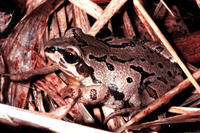STRECKER'S CHORUS FROG

In Kansas, this small (1-1 5/8 inches) chorus frog is at the northern edge of its continental range. Body color may vary from brown to gray, green or hazel. It has a dark line through the eye and a dark spot below and just in front of each eye. There are scattered dark spots and blotches on the animal's back.
Habitat at known locations in Kansas usually consists of shallow, run-off pools of relatively unpolluted water where some wetland vegetation is present and no predator fish occur. Strecker's Chorus Frogs were formerly known to occur only in Barber and Harper counties. In 2004, a disjunct population was found in Pratt, Barber and Kingman counties.

Strecker's Chorus Frogs are protected by the Kansas Nongame and Endangered Species Conservation Act and administrative regulations applicable thereto. Any time an eligible project is proposed that will impact the species' preferred habitats within its probable range, the project sponsor must contact the Ecological Services Section, Kansas Department of Wildlife, Parks and Tourism, 512 SE 25th Ave., Pratt, Kansas 67124-8174. Department personnel can then advise the project sponsor on permit requirements.
DESIGNATED CRITICAL HABITATSAs defined by Kansas Administrative Regulations, critical habitats include those areas documented as currently supporting self-sustaining population(s) of any threatened or endangered species of wildlife as well as those areas determined by the Kansas Department of Wildlife, Parks and Tourism to be essential for the conservation of any threatened or endangered species of wildlife.
Currently, the following areas are designated critical for Strecker's Chorus Frogs:
Due to the intermittency of the individual breeding pools used by Strecker's Chorus Frogs, specific site designations for critical habitats are not made; however, whenever and wherever they occur, all wetlands and rainwater basins and pools within those portions of Barber, Harper, Kingman, and Pratt counties located south of U.S. Highway 42, east of U.S. Highway 281, and west of U.S. Highway 14, including all wetlands and rainwater basins and pools within one mile of Isabel Wetlands are considered critical habitat.







